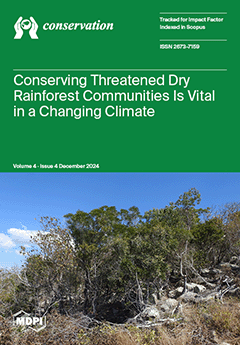Pest rodents cause extensive damage to crops worldwide. Up to 40% of global crop production is lost annually to pests and diseases, with rodents accounting for 15–30% of this loss amounting to billions of dollars each year. The current method of controlling rodent populations involves the extensive use of chemical rodenticides. While effective in the short term, these chemicals pose serious environmental and health risks, leading to secondary poisoning of non-target species and other long-term negative ecological consequences, underscoring the need to adopt more sustainable pest-control measures. Nature-Based Solutions (NbSs), on the other hand, are increasingly recognized for addressing environmental challenges such as climate change, biodiversity loss, and sustainable development, and they include actions that protect, sustainably manage, and restore ecosystems. In this context, Barn Owls (
Tyto alba) are highly effective as a natural pest-rodent control agents in agro-ecosystems. The species has a wide distribution and adaptability to various environments, and its diet consists predominantly of small mammals, with rodents making up from 50–60% up to even 90–95% of the diet according to different geographical regions. Each Barn Owl family can consume thousands of rodents annually, creating a high potential to reduce crop damage and infestations. Deploying nest boxes in agricultural areas can significantly increase Barn Owl populations, ensuring continuous and effective rodent control. Limitations of this solution must also be taken into consideration such as predation on rodents and small mammals that are not pests, and possible competition with other nocturnal birds of prey. Ιn the current paper, we aim to introduce the concept of owls as a NbS for pest rodent control and outline the main challenges, pitfalls, advantages, and disadvantages of implementing this solution in a new geographical region, and all the necessary in-between steps (scientific, societal, administrative, educational) that have to be followed for a successful implementation. So far, several countries have successfully implemented Barn Owl nest box schemes, with Israel and Cyprus achieving reduction in the use of pesticides by 45% and 58%, respectively, whereas the project is spreading to other Mediterranean countries (Jordan, Palestine Authority, Greece, Morocco, Spain), in palm plantations in Malaysia and USA, and in the vineyards of Napa Valley in California. The success of Barn Owl nest box programs relies on integrating scientific research, societal needs, supportive policy frameworks, and education. Barn Owl nest box programs are both bottom-up and top-down initiatives, in need of the participation of farmers and local communities to establish and deploy the Barn Owl solution. Continuous research is also necessary to explore systematically Barn owl trophic ecology, foraging and breeding ecology, interactions with agricultural landscape, and land uses in temporal and spatial scales, and challenges such as habitat suitability, availability of nesting sites, and regional ecological conditions must also be addressed.
Full article





